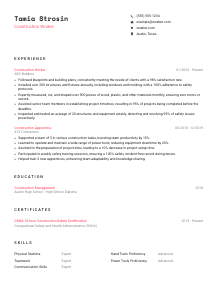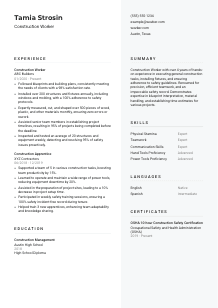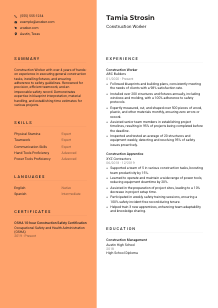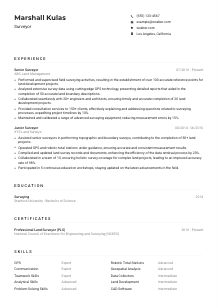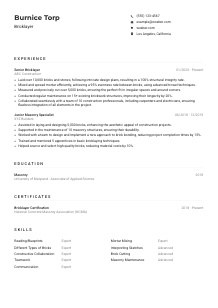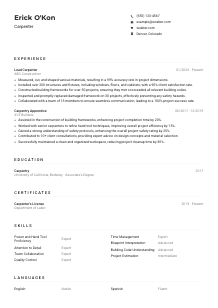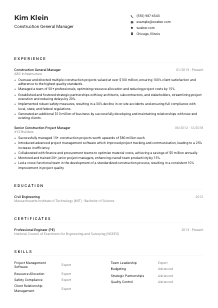Construction Worker CV Example
Building skyscrapers, but your CV feels like a foundation without bricks? Hammer into this Construction Worker CV example, constructed with Wozber free CV builder. See how you can lay out your site savvy to align with job blueprints, making your career as solid as the structures you raise!
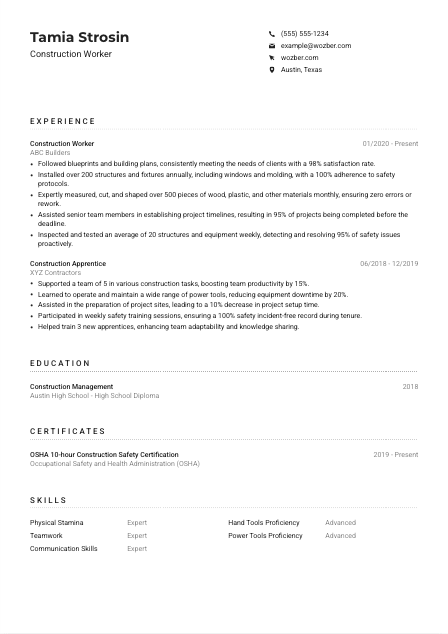
How to write a Construction Worker CV?
Hello, future Construction Worker Maverick! In the construction field, where every brick and bolt counts, it's your CV that lays the groundwork for your career. Your CV isn't just a document, but a tool belt of your professional life. Let's use Wozber, the free CV builder, to craft an ATS-compliant CV that stands solid against the scrutiny of hiring managers and Applicant Tracking Systems (ATS).
Ready to don your hard hat and start building? Let's dive into creating a CV as sturdy as the projects you work on.
Personal Details
The Personal Details section of your CV is the cornerstone, setting the foundation for your professional introduction. Tailoring this section for a Construction Worker position means showcasing your readiness from the get-go. Let's lay the bricks one at a time.
1. Firm Foundation with Your Name
Your name should be the structural beam of your CV, prominent and sturdy. Opt for a font that stands the test of time and stress, a little larger than the rest, so it's the first detail to catch the eye.
2. Blueprints Matching
Position yourself immediately by aligning with the job role. Directly below your name, place the title 'Construction Worker' prominently. This signals to the hiring manager and the ATS that you're a tailored fit for the foundation they're looking to fill.
3. Essential Contact Tools
Like the trusty hammer and tape measure in your tool belt, make sure your contact information is practical and accurate. A reachable phone number without any errors and a professional email are crucial. Imagine firstname.lastname@email.com as the clean, labeled toolbox of your contact section.
4. Location Coordinates
"Must be located in or willing to relocate to Austin, Texas." By stating 'Austin, Texas' clearly in your CV, you align perfectly with this crucial requirement. It's like showing the foreman you're already onsite.
5. Streamlining Your Professional Profile
Adding a LinkedIn profile can be like showcasing your completed projects portfolio. Make sure it's up-to-date and reflects your CV. Keep it relevant to your construction career, bypassing personal websites or blogs unless they specifically showcase your work.
Takeaway
Consider the Personal Details section the foundation of your CV. Approach it as if you're laying the first brick—accurate, aligned, and clear. It's your professional introduction, your handshake before the toolbox opens. Polish it to a shine, and you're ready for your first inspection.





Experience
In the world of construction, your hands-on experience is your greatest testament. Showcasing your project portfolio in the Experience section is like walking the employer through your favorite builds. Let's construct a narrative of success, brick by brick.
- Followed blueprints and building plans, consistently meeting the needs of clients with a 98% satisfaction rate.
- Installed over 200 structures and fixtures annually, including windows and molding, with a 100% adherence to safety protocols.
- Expertly measured, cut, and shaped over 500 pieces of wood, plastic, and other materials monthly, ensuring zero errors or rework.
- Assisted senior team members in establishing project timelines, resulting in 95% of projects being completed before the deadline.
- Inspected and tested an average of 20 structures and equipment weekly, detecting and resolving 95% of safety issues proactively.
- Supported a team of 5 in various construction tasks, boosting team productivity by 15%.
- Learned to operate and maintain a wide range of power tools, reducing equipment downtime by 20%.
- Assisted in the preparation of project sites, leading to a 10% decrease in project setup time.
- Participated in weekly safety training sessions, ensuring a 100% safety incident‑free record during tenure.
- Helped train 3 new apprentices, enhancing team adaptability and knowledge sharing.
1. Analyze the Site Plan
Start with understanding every requirement of the job description. Break it down like a project site plan, identifying the key components. This lays the groundwork for a strong, relevant Experience section.
2. Erecting Timelines
Chronologically order your positions, placing the most recent ones at the top, similar to how you'd stack levels on a building. For each position, list your job title, company name, and the timeframe you were employed there, creating a clear, strong structure.
3. Crafting Your Achievements
"Installed over 200 structures and fixtures annually...with a 100% adherence to safety protocols." This bullet point isn't just an achievement; it's concrete proof of your skill and reliability. Detail your responsibilities and triumphs that align with the job specs.
4. Adding Measurements
Numbers in construction are as vital as in your CV. They offer scale and impact—quantifying your achievements with hard stats helps the hiring manager gauge the scope of your capabilities.
5. Relevant Work Zone
Keep only the job experiences that directly relate to the Construction Worker role. It ensures every line in your CV is focused and relevant, like every brick in a well-constructed wall.
Takeaway
Think of the Experience section as the main structure of your career build. It's where you prove your worth with every line. Align each task and achievement directly to the job spec, showcasing why you're not just a great fit, but the best fit for the role. Remember, you're not just showing where you've been; you're mapping out where you can go with them.
Education
Education in the construction world often extends beyond the traditional classroom. It's about the knowledge and skills honed both on the ground and from the books. Let's frame your educational background in a way that builds your case as the top candidate.
1. Understanding the Blueprint
Identify the essential educational elements the job demands. In construction, practical experience often weighs as much as formal education, reflecting a balance between the two.
2. Erecting Educational Pillars
Structure this section for clarity and impact. List your degree, the field of study, and the institution—much like laying out the blueprint of a building, ensuring each segment supports the next.
3. Framing Your Qualifications
In a sector where certifications often hold as much value as degrees, ensure your highest level of relevant education is front and center. It's like highlighting the main beam of a project that supports the rest.
4. Specialized Knowledge Blocks
If you've taken courses or seminars that are directly applicable to the construction sector, list them. It's like adding those refined finishes to a project that really make it stand out.
5. Commemorating Your Achievements
Honors, leadership roles, or significant projects during your educational journey are like the cornerstone of a building—representative of its strength. If they're relevant, let them shine, but make sure they support the structure of your CV.
Takeaway
Your Education section lays the groundwork for your skills and dedication. Build it with attention to what the job requires and how you meet those demands. It's not just about where you've been educated but how that education has prepared you for the challenges on the construction site. Craft it well, and your foundation will be solid.
Certificates
In the construction world, certifications can be the gold standard for assessing expertise and safety knowledge. They're like the hardhat of your CV—essential for protection and a sign of professionalism. Let's detail how to display them to catch the hiring manager's eye.
1. Sorting Your Tools
Revisit the job description to pinpoint exactly what certifications are preferred, such as the "OSHA 10 or 30-hour Construction Safety Certification." This ensures you highlight the most relevant credentials.
2. Highlighting Safety and Skill
Focus on the certifications that speak directly to the job's demands, showcasing your commitment to safety and quality. It's like showing the building inspector you've passed with flying colors.
3. Time-Stamping Your Qualifications
If your certification has an expiration date, make sure to include when you earned it. Keeping certs up-to-date is critical in the construction industry, akin to ensuring your safety gear is always in prime condition.
4. Ongoing Learning and Construction
The construction sector is always evolving, with new standards and technologies. Highlight recent or advanced certifications to demonstrate your commitment to staying at the leading edge, much like keeping blueprints up to the current code.
Takeaway
Think of each certification as a specialized tool in your belt, ready to be deployed. They're not just credentials; they're proof of your dedication to safety, skill, and continuous improvement. Highlight them wisely, and they'll speak volumes about your professionalism and readiness for the job.
Skills
In construction, your skill set is your most valuable tool. The Skills section of your CV is where you inventory those tools—both the hard skills and the soft skills that make you an exceptional Construction Worker.
1. Inventory the Blueprint
Start by mapping out the skills directly mentioned in the job description. These are the tools you absolutely need in your belt to fit the job spec perfectly.
2. Highlighting Your Core Tools
"Proficiency with hand and power tools," "strong physical stamina and dexterity," and "excellent teamwork and communication skills" are the heavy-duty tools of your trade. Make sure these are front and center on your CV, paired with real-world usage scenarios.
3. Neat Layout for Easy Access
Like a well-organized tool chest, your skills section should be clean and accessible. Prioritize and list them in a way that instantly communicates your capabilities to the hiring manager.
Takeaway
Approach the Skills section as a showcase of the most valuable tools you bring to the job site. It's an opportunity to demonstrate your hands-on efficiency and your soft-skills savvy. Keep it concise, relevant, and reflective of the job's demands. Remember, every skill you list is a testament to your craftsmanship. Make each one count.
Languages
While not always front and center in construction, your linguistic skills can cement your place in a multicultural work environment. They reflect your ability to navigate the diverse landscape of today's construction sites. Let's articulate this unexpected addition.
1. Inspecting the Blueprint
First, review if specific language abilities are mentioned in the job description. For instance, "English language abilities must be at a professional level." This is a foundational requirement you can't overlook.
2. Building Your Language List
Start with the languages critical for the job, indicating your proficiency. Like laying the primary pipelines for a build, ensure these foundational languages are prominently mentioned.
3. Adding to Your Language Scaffold
While the job might specify particular languages, don't hesitate to list additional ones you know. Each language is like an extension to your skillset, potentially unlocking more opportunities on the job site.
4. Accurate Measurement of Proficiency
Be honest and precise about your language levels. Whether you're "Native," "Fluent," "Intermediate," or "Basic," clarity here is as vital as the correct measurements in a project plan.
5. Understanding the Scope of Communication
Recognize the broader context of your linguistic abilities. In an industry that thrives on teamwork and collaboration, being able to communicate with a diverse team is invaluable, much like ensuring everyone has the blueprints in a language they understand.
Takeaway
Your language skills are more than just words on paper; they're indicative of your ability to operate in a multicultural work environment. Highlighting them demonstrates your adaptability and readiness to communicate on diverse project sites. Remember, every language you speak is a bridge to better collaboration and understanding in the global construction arena.
Summary
The Summary section is your elevator pitch—the concise argument for why you are the ideal candidate for the Construction Worker position. It's about framing your qualifications, experience, and aspirations in a way that grabs attention and lays a solid foundation for the rest of your CV.
1. Surveying the Job Landscape
Begin by immersing yourself in the job description. Understand the kind of candidate they're seeking and tailor your summary to match that blueprint, brick for brick.
2. Constructing Your Opening Line
Initiate with a powerful statement that encapsulates your profession and level of experience. Think of it as setting the cornerstone of your professional narrative.
3. Layering in Your Skills and Achievements
Highlight your most relevant skills and notable achievements. Like the critical supports of a structure, choose the elements that will bear the most weight in showcasing your capability for the role.
4. Finishing with Precision
Conclude your summary with a clean, compelling line that signifies your readiness and eagerness for the position. It's the final polish on your professional summary, ensuring it shines.
Takeaway
The Summary is your chance to make a memorable first impression, to show you've read the blueprint and you're ready to get to work. Tailor it to echo the job description, reflecting that you're not only capable but excited for the opportunity. This is your professional signal flare; make sure it shines bright above the competition. Ready, set, build your future with Wozber!
Launching Your Construction Worker Journey
As we wrap up our blueprint to a compelling Construction Worker CV, remember this: Your CV is the foundation on which your job search builds. Utilizing Wozber's free CV builder, ATS-friendly CV templates, and ATS CV scanner for optimisation, you're equipped with the best tools to craft a CV that stands as strong as the structures you help build. Your career in construction is a testament to your skill, resilience, and dedication. Let your CV reflect that.
Start crafting your ATS-compliant CV today and cement your path to success. The construction world awaits your expertise. Let's build a future, one CV at a time.

- Minimum of 2 years of experience in general construction or related field.
- Proficiency with hand and power tools.
- Strong physical stamina and dexterity, with the ability to lift heavy objects and work in all weather conditions.
- Excellent teamwork and communication skills.
- Valid OSHA 10 or 30-hour Construction Safety Certification is preferred.
- English language abilities must be at a professional level.
- Must be located in or willing to relocate to Austin, Texas.
- Follow blueprints and building plans to meet the needs of clients.
- Install structures and fixtures, such as windows and molding.
- Measure, cut, or shape wood, plastic, and other materials.
- Assist in establishing project timelines and ensuring deadlines are met.
- Inspect and test structures and equipment for safety and quality.





